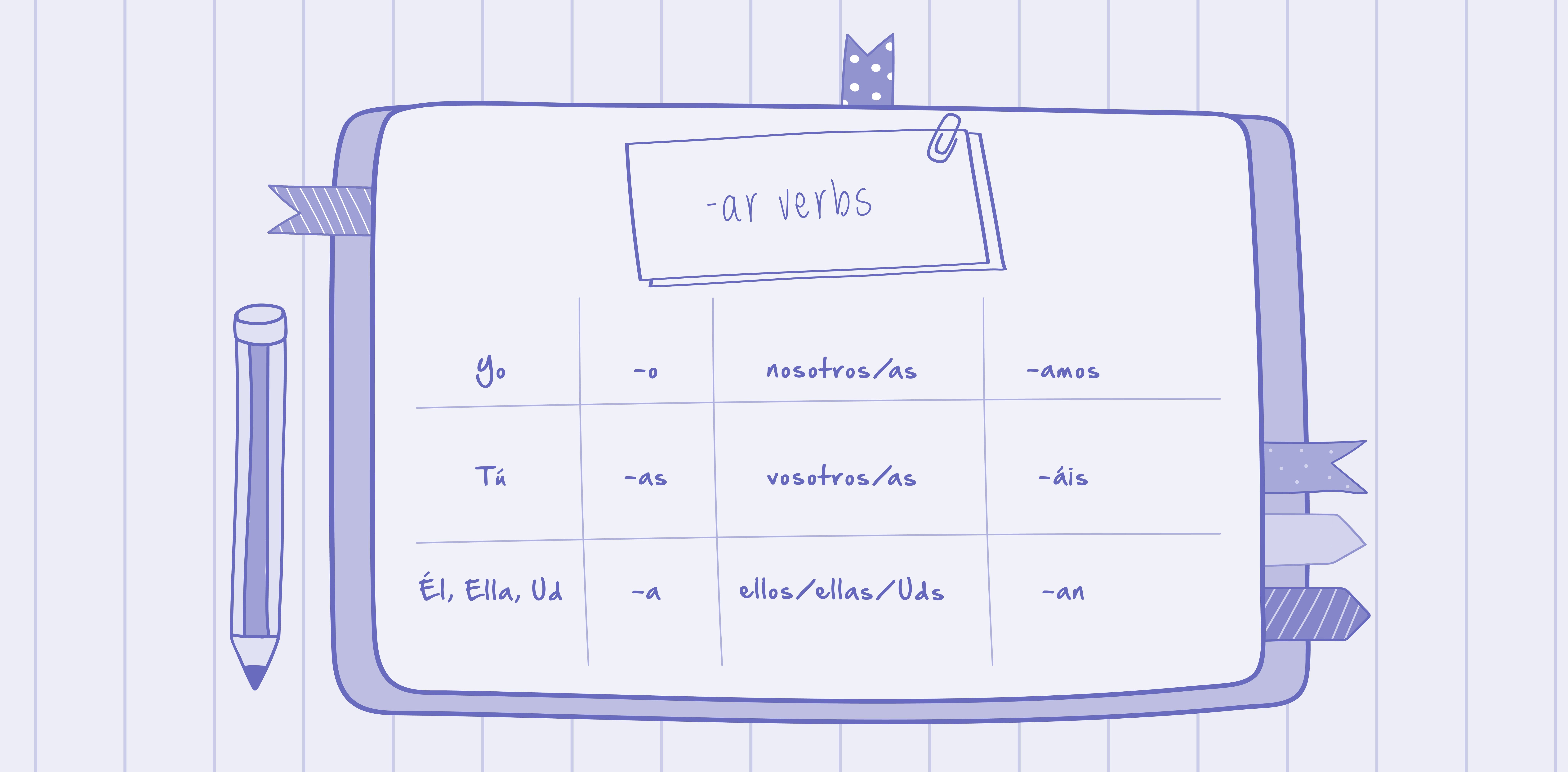
Are you eager to speak Spanish fluently? One of the critical steps towards achieving this goal is mastering Spanish ER verbs.
As an English speaker, you might find these verbs a bit tricky to grasp initially. The conjugation rules, tense changes, and exceptions can seem overwhelming. But, if you’re finding it hard to form sentences correctly and naturally, you’re not alone - many learners share these challenges.
If you don't tackle these ER verbs head-on, however, your journey to becoming fluent in Spanish could be longer and more difficult than it needs to be. Imagine being in a conversation with native Spanish speakers and constantly pausing or making errors because you're uncertain about using verb conjugations. It can be frustrating and may even deter you from learning further.
But, there's good news! This blog post will help you overcome these hurdles. We'll delve deep into Spanish verbs, particularly ER verbs, breaking down their conjugation rules, exploring their usage in different tenses, and giving you practical examples to apply what you learn.
Learn Spanish with Langster
What Are ER Verbs?
ER verbs in Spanish are a category of verbs in Spanish that end in “-er.” This is one of the three classifications of verbs in Spanish, the other two being “-ar” and “-ir” verbs.
The term “ER verb” comes from the infinitive form of the verb. In Spanish, all verbs in their untouched, dictionary form end in either “ar,” “er,” or “ir.” For example, the verb comer (to eat) is an ER verb because it ends with “-er” in its infinitive form.
These verbs follow a specific pattern for conjugation based on the subject of the sentence. Understanding this pattern is crucial for using the verbs correctly in different contexts and tenses. In the following sections, we'll explore how to conjugate and use these ER verbs effectively to master Spanish grammar.
The Basics of ER Verbs

ER verbs are quite common in the Spanish language. Here are some of the most common ER verbs:
Spanish
English
comer
to eat
beber
to drink
leer
to read
correr
to run
vender
to sell
entender
to understand
aprender
to learn
responder
to answer
romper
to break
proteger
to protect
Now, let's delve into the basic conjugation rule for ER verbs in the present tense. In Spanish, when we conjugate verbs, we remove the infinitive ending (“-er” in this case) and add a new ending that matches with the subject of the sentence.
Here is the present tense conjugation pattern for ER verbs:
| Pronoun | Ending |
|---|---|
| Yo (I) | -o |
| Tú (You, informal singular) | -es |
| Él, Ella, Usted (He, She, You, formal singular) | -e |
| Nosotros, Nosotras (We) | -emos |
| Vosotros, Vosotras (You, informal plural) | -éis |
| Ellos, Ellas, Ustedes (They/You, formal plural) | -en |
| Pronoun | Ending |
|---|---|
| Yo (I) | -o |
| Tú (You, informal singular) | -es |
| Él, Ella, Usted (He, She, You, formal singular) | -e |
| Nosotros, Nosotras (We) | -emos |
| Vosotros, Vosotras (You, informal plural) | -éis |
| Ellos, Ellas, Ustedes (They/You, formal plural) | -en |
For example, if we take tener (to eat), it would be conjugated as follows in the present tense:
| Yo tengo | I have |
| Tú tienes | You have |
| Él, Ella tiene | He, She has |
| Nosotros, Nosotras tenemos | We have |
| Ellos, Ellas, Ustedes tienen | They have, You all have |
| Yo tengo | I have |
| Tú tienes | You have |
| Él, Ella tiene | He, She has |
| Nosotros, Nosotras tenemos | We have |
| Ellos, Ellas, Ustedes tienen | They have, You all have |
Remember, these are the general rules for regular ER verbs. There are some irregular ER verbs that follow different conjugation patterns, which we will cover later in this guide.
Conjugating ER Verbs in Different Tenses
Understanding how to conjugate ER verbs in various tenses is vital for mastering Spanish. Let's explore how to do this in the past, future, and conditional tenses using the verb beber, which translates as “to drink” in English.
Preterite Tense
| Beber | to drink |
|---|---|
| yo bebí | I drank |
| tú bebiste | you drank |
| él, ella bebió | he, she drank |
| nosotros, nosotras bebimos | we drank |
| ellos, ellas, ustedes bebieron | they, you all drank |
| Beber | to drink |
|---|---|
| yo bebí | I drank |
| tú bebiste | you drank |
| él, ella bebió | he, she drank |
| nosotros, nosotras bebimos | we drank |
| ellos, ellas, ustedes bebieron | they, you all drank |
Future Tense
| Beber | to drink |
|---|---|
| yo beberé | I will drink |
| tú beberás | you will drink |
| él, ella beberá | he, she will drink |
| nosotros, nosotras beberemos | we will drink |
| ellos, ellas, ustedes beberán | they, you all will drink |
| Beber | to drink |
|---|---|
| yo beberé | I will drink |
| tú beberás | you will drink |
| él, ella beberá | he, she will drink |
| nosotros, nosotras beberemos | we will drink |
| ellos, ellas, ustedes beberán | they, you all will drink |
Conditional Tense
| Beber | to drink |
|---|---|
| yo bebería | I would drink |
| tú beberías | you would drink |
| él, ella bebería | he, she would drink |
| nosotros, nosotras beberíamos | we would drink |
| ellos, ellas, ustedes beberían | they, you all (formal) would drink |
| Beber | to drink |
|---|---|
| yo bebería | I would drink |
| tú beberías | you would drink |
| él, ella bebería | he, she would drink |
| nosotros, nosotras beberíamos | we would drink |
| ellos, ellas, ustedes beberían | they, you all (formal) would drink |
Pluscuamperfecto

The Pluperfect tense is used to talk about something that had happened before another action in the past. For this tense, we use the imperfect form of the auxiliary verb haber followed by the past participle of the main verb.
| Beber | to drink |
|---|---|
| yo había bebido | I had drunk |
| tú habías bebido | you had drunk |
| él, ella había bebido | he, she had drunk |
| nosotros, nosotras habíamos bebido | we had drunk |
| ellos, ellas, ustedes habían bebido | they, you all (formal) had drunk |
| Beber | to drink |
|---|---|
| yo había bebido | I had drunk |
| tú habías bebido | you had drunk |
| él, ella había bebido | he, she had drunk |
| nosotros, nosotras habíamos bebido | we had drunk |
| ellos, ellas, ustedes habían bebido | they, you all (formal) had drunk |
Imperfect Past Tense
The Imperfect Past tense is used to describe habitual or continuous actions in the past. It's also used to talk about characteristics in the past.
| Beber | to drink |
|---|---|
| yo bebía | I was drinking |
| tú bebías | you were drinking |
| él, ella bebía | he, she was drinking |
| nosotros, nosotras bebíamos | we used to drink, we were drinking |
| ellos, ellas, ustedes bebían | they, you all were drinking |
| Beber | to drink |
|---|---|
| yo bebía | I was drinking |
| tú bebías | you were drinking |
| él, ella bebía | he, she was drinking |
| nosotros, nosotras bebíamos | we used to drink, we were drinking |
| ellos, ellas, ustedes bebían | they, you all were drinking |
Introduction to Irregular ER Verbs

Irregular verbs in Spanish do not follow the standard conjugation patterns of regular ER verbs. They have their own unique sets of endings or may undergo spelling changes in their stems. These irregular verbs are crucial to learn, because they are often some of the most commonly used verbs.
Let's look at two common examples: tener (to have) and saber (to know).
Tener (To Have)
In the present tense, tener undergoes a stem change from “e” to “ie,” except in nosotros/nosotras.
| Tener | to have |
|---|---|
| yo tengo | I have |
| tú tienes | you have |
| él, ella tiene | he, she has |
| nosotros, nosotras tenemos | we have |
| ellos, ellas, ustedes tienen | they, you all (formal) have |
| Tener | to have |
|---|---|
| yo tengo | I have |
| tú tienes | you have |
| él, ella tiene | he, she has |
| nosotros, nosotras tenemos | we have |
| ellos, ellas, ustedes tienen | they, you all (formal) have |
Saber (To Know)
Saber is an irregular verb in the first person singular (yo) form in the present tense.
| Saber | to know |
|---|---|
| yo sé | I know |
| tú sabes | you know |
| él, ella sabe | he, she knows |
| nosotros, nosotras sabemos | we know |
| ellos, ellas, ustedes saben | they, you all (formal) know |
| Saber | to know |
|---|---|
| yo sé | I know |
| tú sabes | you know |
| él, ella sabe | he, she knows |
| nosotros, nosotras sabemos | we know |
| ellos, ellas, ustedes saben | they, you all (formal) know |
Remember, these are just a couple of examples. There are many more irregular ER verbs in Spanish, each with its own quirks and rules. Practice and repetition are the keys to mastering them.
Common Mistakes English Speakers Make When Using ER Verbs
Navigating the intricacies of Spanish grammar can be challenging, and one area many learners find difficult is using ER verbs.
Below, we delve into common mistakes that English speakers make when learning these verbs, along with some tips to avoid them!
- Incorrect conjugation. One of the most common mistakes is using the wrong conjugation of the verb. English speakers often struggle with the numerous Spanish verb tenses and their corresponding conjugations.
- Misuse of infinitive form. English speakers tend to use the infinitive form of the verb instead of conjugating it. For example, they might say Yo necesito beber instead of Yo necesito bebo (I need to drink).
- Stem-changing verbs. Some ER verbs are stem-changing. English speakers might not be aware of these changes and use the regular form. For instance, they might conjugate tener as teno instead of tengo.
- Irregular verbs. Irregular verbs are a significant challenge, as they do not follow standard conjugation rules. English speakers might use regular patterns for these verbs, leading to errors.
Tips to Avoid These Mistakes
- Practice regularly. The key to mastering ER verbs is consistent practice. Regularly practicing conjugation exercises can help you become more familiar with the patterns.
- Learn the most common verbs. Start by learning the most commonly used ER verbs and their conjugations. This will give you a solid foundation to expand your vocabulary.
- Use language apps. There are numerous language learning apps that offer interactive exercises and quizzes to practice verb conjugations.
- Engage in conversation. Try to engage in conversations with native or fluent Spanish speakers. This will give you real-world practice and help you understand the usage of ER verbs in different contexts.
- Take note of irregular verbs. Pay special attention to irregular verbs, as they do not follow the regular conjugation patterns. Make a list of these verbs, and practice them regularly.
Remember, making mistakes is a part of the learning process. Don't be discouraged if you make errors. Instead, use them as an opportunity to learn and improve.
Conclusion

Learning a new language, especially its verbs and conjugations, is like embarking on an exciting journey. It can be challenging at times, particularly for English speakers learning Spanish ER verbs due to their various forms, irregularities, and stem changes. However, it's important to remember that making mistakes is not only normal but also a crucial part of the learning process.
The key to mastering Spanish ER verbs lies in regular practice, understanding the common patterns, and being mindful of the exceptions. Utilizing modern resources, such as language apps like Langster, engaging in conversations with native speakers, and practicing continuously can significantly enhance your command over ER verbs.
Every step, no matter how small, takes you closer to fluency. So, embrace the challenges, learn from your mistakes, and keep practicing. Your efforts will soon bear fruit, opening up a new world of communication and cultural understanding. Keep going, and soon, you'll find yourself conversing confidently and correctly in Spanish!
Learn Spanish with Langster









